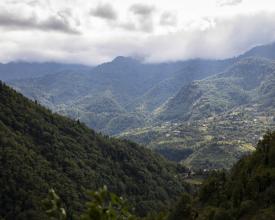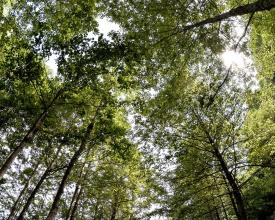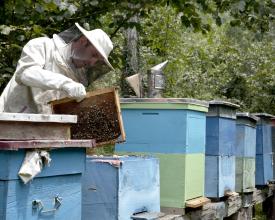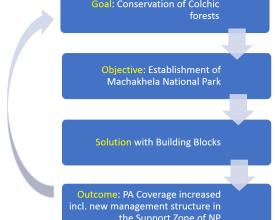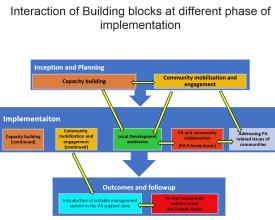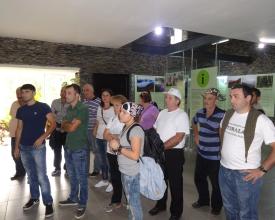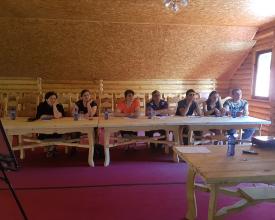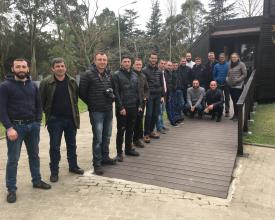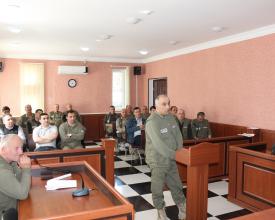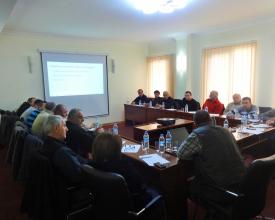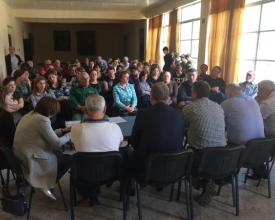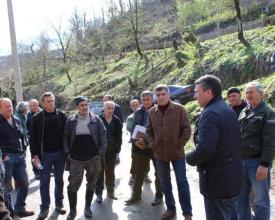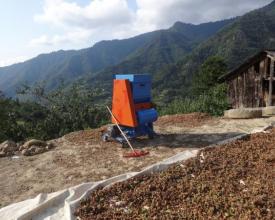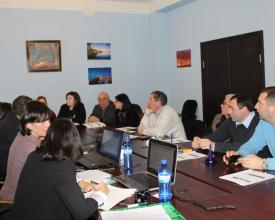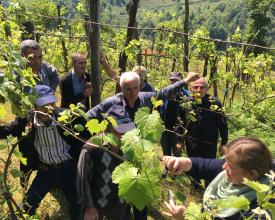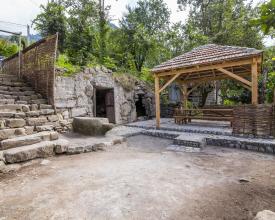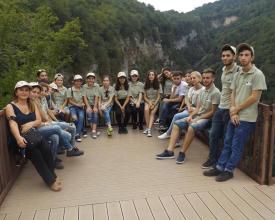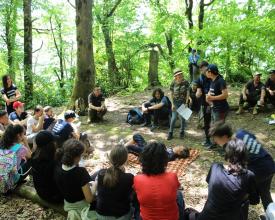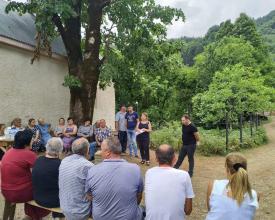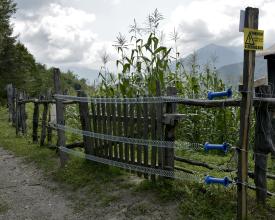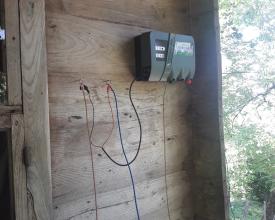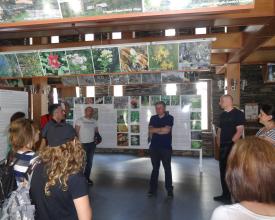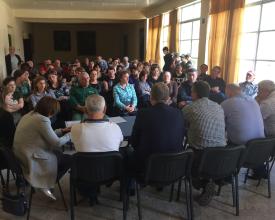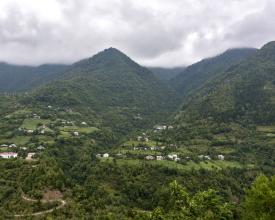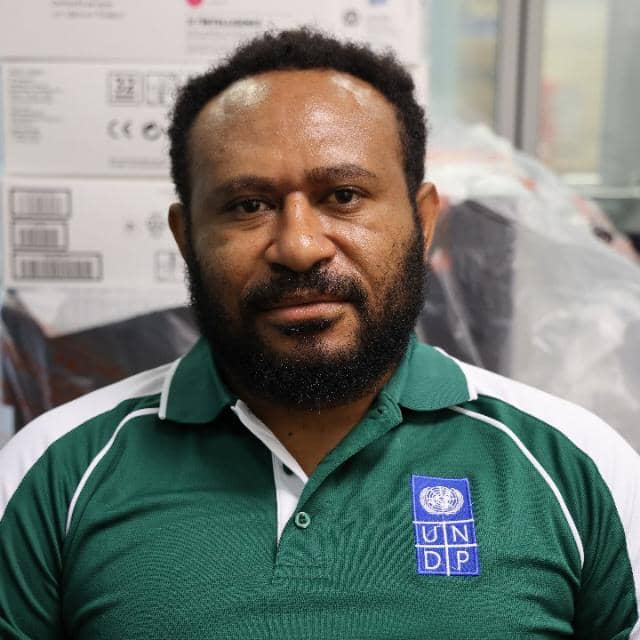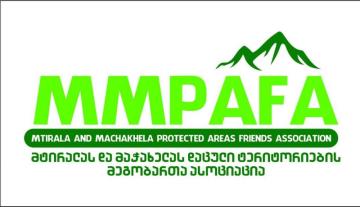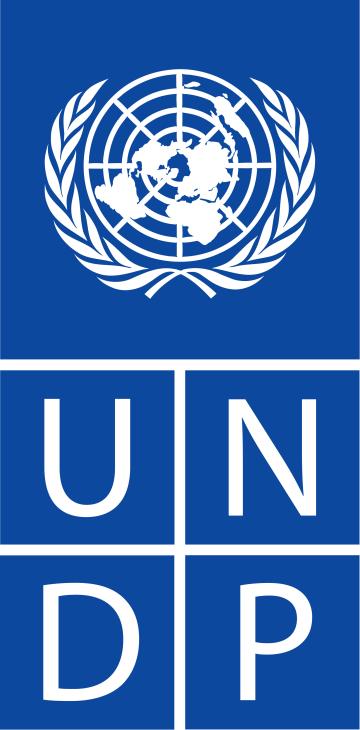
Establishment of Colchic forest protected area: from opposition to advocacy and expansion
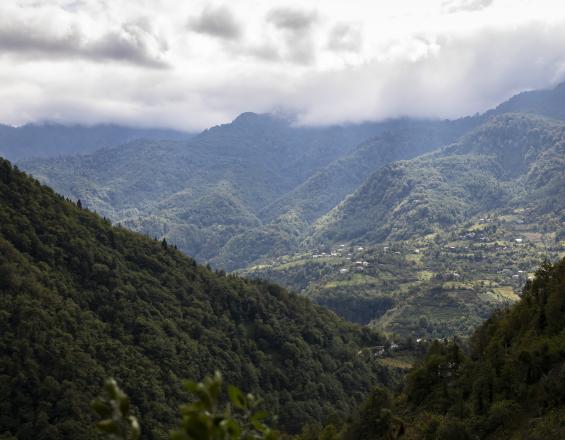
A significant part of Georgia’s Ajara region is covered with the globally unique colchic type of forests (relic temperate rainforest). Machakhela National Park (NP), which lies between Mtirala NP and the Turkish border, was established in 2012 to enhance the biogeographic coverage and connectivity of this forest by adding an additional link in the chain of the 3 existing Protected Areas (PA) (Kintrishi and Mtirala in Georgia and Jamili in Turkey).
Based on a set (blocks) of integrated activities, the UNDP-supported and GEF-financed “Achara Protected Areas project" has developed a solution that has helped to convert a mainly “paper park” into a functional PA, and changed the attitude of the local population from mistrust and opposition to now being supportive of conservation and sustainable landuse / livelihood development in the Machakhela valley.
Context
Challenges addressed
- The NP had no capacity to achieve conservation goals: no clearly defined boundaries, zoning, trained staff, office, equipment or management/operational plans
- Opposition by local communities to the establishment of NP and to any actions in the valley, perceived as restricting existing landuse & livelihoods
- Some areas of high biodiversity value weren't included into the territory of the NP
- Poorly developed community structures and limited collective vision about future development
- High dependence on fuelwood for heating, resulting in pressure and damage to forest through poor extraction practices; risk, time and expense for households
- Significant human-wildlife conflicts causing damage & losses to households; lack of data and means by which they could get support for addressing the issue
- Limited income opportunities, absence of tourism infrastructure, low numbers of tourists, inexperience of potential service providers about suitable tourism service
Location
Process
Summary of the process
- Capacity building that combines and integrates trainings relevant to a variety of stakeholders is an effective way to broaden understanding and awareness of all parties and to build a wide basis of local capacities and knowledge
- Support zone community mobilization has increased their capacity to mobilize and cooperate to achieve mutual social and development goals
- Development assistance resulted in increased possibility and capacity for communities to develop and benefit from tourism opportunities and improve livelihoods from sustainable natural resource use
- To support PA and local community cooperation, a self-sustaining NGO aiming to support the long-term development and collaboration of PAs and communities has been established and functioning
- Addressing specific issues related to the PA establishment such as boundary demarcation involving local communities, introduction of fuelwood alternatives and solutions to human wildlife conflict have increased trust and support to PAs
- Introduction of suitable management system in the support zone will ensure that all the high value biodiversity and cultural landscape of the valley is covered by a viable management system
Building Blocks
Capacity Building of Protected areas administration and local stakeholders
The objective of the project was to increase the long-term effectiveness of conservation and land use in the colchic forests of Ajara, and this necessitated building the capacity of all relevant stakeholders to undertake appropriate activities and development in the future.
To build such capacity, the project pursued a multi-faceted approach involving:
- provision of key equipment and infrastructure to National Park (NP) and local households
- practically orientated trainings of Protected Areas (PA) staff and local stakeholders – formal / semi -formal training by specialist trainers or contractors
- study tours within Georgia
- in process / on-job practical experience
In the latter case, the project strategy was to ensure involvement of project stakeholders as much as possible in the activities led by outside contractors and consultants. The rationale behind this was to build as much local practical experience as possible in order to maximize the possibilities for beneficiaries to be able to undertake such activities themselves in the future. In other words, to build the practical experience and “on-job” capacity of beneficiaries (PA staff, local communities, local service providers, etc.).
Enabling factors
- Building of trust through better communication. During the initial implementation, particular focus was placed on building communication and trust between the National Park and local stakeholders in order to enable future meaningful cooperation.
- Gaining a sound understanding of local stakeholder issues and priorities. Studies undertaken at the outset were critical in identifying the real capacity building needs of both NP and local stakeholders and helped to orientate project support
- Participation and input from local stakeholders.
Lesson learned
- Combining formal training with on-job practical application of skills (when feasible) is much more effective to build long term sustained capacity. For example, training on law enforcement
- A holistic training approach that combines and integrates trainings relevant to a variety of stakeholders in a PA context (i.e. not just PA staff but local community, municipalities, NGOs, etc.) is an effective way to both broaden understanding and awareness of all parties, and build a wide basis of local capacities and knowledge (e.g. visit of stakeholders to other PAs)
- The existence of a systematic training plan/programme within Agency of Protected Areas (APA) and the retention of relevant training materials and training service providers (i.e. a training clearing house mechanism) could greatly enhance the future effectiveness of relevant training for PA staff
- Collaboration of capacity development efforts with other donor projects can be an effective means to ensure cost effectiveness and access for additional resources, as well as ensuring a more coordinated approach
Machakhela National Park (MNP) support zone community mobilization and engagement in protected area planning and management
When the project started in 2014, there was a significant level of misunderstanding, mistrust and opposition by local residents to the establishment of the MNP and to any actions in the valley that were perceived as restricting existing land use and livelihoods.
To respond to this, the project has:
a) Initiated immediate actions such as the PA staff trainings and community meetings organized in each village, involving newly trained MNP staff, to improve:
- the effectiveness and understanding of newly recruited staff about the NP objectives and how to communicate with local communities and
- the understanding of local communities on the real impact of the NP and its potential benefits
b) Ensured that the boundary and demarcation activities for the MNP were carried out with the full consultation and involvement of local communities and that the final boundaries were consensually agreed with them
c) Worked actively with the local communities to build their capacity to organize and benefit from the opportunities the establishment of the NP could bring
d) Initiated activities, with involvement of the MNP administration, to address priority issues for local communities related to forest resources and wildlife (i.e. fuel wood alternatives, human / wildlife conflict).
Enabling factors
- The MNP administration understood the need to broaden their focus from “traditional” protection oriented activities and to encourage practical collaboration with local communities regarding their priority issues (fuelwood), conflict issues (wildlife damages) and livelihood issues (tourism).
- Initial surveys carried out at the MNP establishment stages included assessment of relevant aspects of the socio-economic situations and natural resource use issues and relevant community priorities, and were incorporated into PA management planning
Lesson learned
- Engaging with communities adjacent to protected areas, particularly during the process of establish the PAs, can have significant benefits for the management of those PA’s in terms of: building local awareness and understanding of their aims, reduction of opposition and conflicts, and finding positive collaborative opportunities of mutual benefit
- Protected areas establishment process with strong community support component can be effective catalysers of rural development, helping to build more sustainable and resilient livelihoods, and more united communities
- In communities with weak cohesion or existing self-organization structures, it is important to initiate support by efforts to strengthen community level consensus and capacities to organize – this creates an effective basis for further meaningful involvement
- Development support should be driven by community and household priorities, provided they do not conflict with the wider conservation and sustainable resource use goals, not by priorities set by “outsiders” (donor projects, PA agency, etc)
Tourism development inside and adjacent to Machakhela National Park
Appropriate tourism development is an important means and opportunity for Protected areas (PA) and communities located adjacent to them to meet their aims and needs.
In the case of the Protected Areas, the aims are:
- to provide a recreational service to visitors
- to increase public awareness and understanding of the importance of conservation
- to generate incomes that enhance management and strengthen sustainable financing for that purpose.
In the case of local communities, the aim is to increase sustainable incomes, improve and diversify livelihoods.
In both cases, the emphasis is on “appropriate” tourism, i.e. tourism that does not overwhelm or degrade the fundamental tourism attraction (i.e. the pristine nature and cultural landscape). In the PA’s case, there is also an emphasis on educational and awareness aims. This requires that tourism development is carefully planned and focuses on maximizing overall longterm benefits, rather than short term financial benefits.
In this context, project's support concentrated initially on developing a sound strategic vision for the Ajara PA system as a whole and individual colchic forest PAs in particular. On this basis, appropriate tourism development was supported on the ground both in the new Machakhela NP and generally in the valley.
Enabling factors
- Existence of well-developed tourism sector on the Black Sea coast and generally “pro-tourism” policy of the Ajara and Georgian government
- Development of a long-term tourism development policy that attempted to balance benefits with core conservation aims helped to build initial consensus and understanding of issues and approaches within Ajara-level tourism actors and national PA actor - the Agency of PAs
-
Use of regionally-based contractors helped to ensure incorporation of the input and experience of the existing tourism enitities
Lesson learned
- There is a very significant opportunity for colchic forest PAs to increase visitor numbers based on their nature values alone, without investments in substantial infrastructure – the primary “marketing value" of PA's are their intrinsic scenic and nature values, not artificial “attractions” which may be inappropriate.
- Tourism operators are often focused on quantity of service and not quality - for ecologically and culturally sensitive destinations like Machakheli, tour operators need to prioritize sustainability criteria and focus on quality over quantity.
- Individual consultations and trainings on the job appear as a most successful method and acceptable for locals in terms of capacity building.
- Management of PA should build more intensive communication with local community, involve them in decision making process for product development. Machakhela NP should be communicated by Agency of PA, local government and tourism department of Ajara as integral part of the Valley. Tourism development strategies and action plans should be communicated to local community
Support Protected Area (PA) and community cooperation through the Protected areas Friends Association (FA)
At the project inception, neither Mtirala or Machakhela National Parks were supported by any locally-based NGO’s or support groups. However, such an organization could play an important role in: promoting the PAs, building local community and PA collaboration, and addressing their development priorities.
Based on an assessment of the international and national experience and particularly the existing experience of other PA’s in Georgia, the project supported the establishment and functional capacity building of the Mtirala and Machakhela PAs Friends Association (FA).
The major risk identified was that many such organizations are heavily supported by donors and once such support ceases, they face problems to remain financially viable. Thus, a major focus of support was on building capacity of the FA to be financially sustainable in the long run via a strategy that ensures long-term core funding from reliable sources.
The Mtirala and Machakhela FA was established in 2016 and has been undertaking a variety of activities to build PA/Local Community relationships and collaboration, ranging from Junior and Community Ranger Programs, organization of ecological visits by schools, tourism promotion and application/implementation of local development projects with donor funds.
Enabling factors
- Existing national experience of establishing a similar NGO to support a Protected Area (Tusheti National Park) and an active, relatively established civil society in the country
- A focus from the outset on building the NGO financial sustainability and ensuring of bringing in the existing in-country capacity and experience to support the initial establishment process.
- The existence of national “summer camp” programme and tradition for schools and thus an existing opportunity of the NGO to tap into demand for services.
Lesson learned
- Support to the establishment of conservation/rural development NGOs is a popular mechanism for donor projects to implement activities. However, they face significant challenges in terms of maintaining ongoing financial viability and maintenance of their original mandates and objectives.
- There is demand for environmental education and awareness services in Georgia, particularly in the context of youth summer camps and similar youth related experience building events. This provides a potential source of core financing for PA related NGOs while remaining true to their intended aims.
- There is limited experience and capacity within Georgia on the sustainable organization and management of NGOs/CBOs, particularly regarding sustainable financial planning. This is an aspect that needs support and focus by donors.
- The Junior Ranger approach to involve local communities and the education of local future generations, is a popular, highly viable, and cost effective approach. The application of the Community Ranger approach is more challenging and requires the right circumstances and approach.
Addressing specific concerns of local communities, associated with establishment of Machakhela National Park (MNP)
Establishment of the National park had some specific impact on the communities living in the valley, such as limitation of access to the fuelwood and aggravation of human-wildlife conflict.
The classic approach used by the PA system to address both scenarios would be based on control and penalization of illegal activities. However, the project approach was to try to address the root cause of the issues and thus reduce the basis for conflict between the MNP and local communities.
In the fuelwood case, the project has initiated activities that try to reduce overall demand though increased efficiency of use and fuelwood alternatives. In close consultation with local households, the project assessed potential alternatives, practically tested and demonstrated the chosen options with households, and on that basis disseminated results and encouraged replication.
Likewise, in the case of human/wildlife conflict issue, the project approach was to test methods to mitigate the problem by assessing the situation and testing approaches that are selected after an evaluation of practicality and feasibility.
In both cases, a key aspect was the direct involvement of the MNP Administration so that they can become seen as part of the solution to local households problems, rather than a cause.
Enabling factors
- Availability of competent organizations with specific knowledge and experience to perform feasibility surveys and assessment of alternatives
- Openness of the MNP Administration to engage practically in support of household initiatives, such as support provided to households in bulk buying of hazelnut shells used as a fuelwood alternative.
Lesson learned
- Introduction of alternative solutions should be promoted and prioritized in regional and national forestry, protected areas, rural development and climate change mitigation/adaption strategies and plans. All relevant actors, particularly the PA administrations, forestry agencies, municipalities, NGOs and donor institutions should promote the greater awareness, demonstration and facilitation of the uptake of appropriate solutions due to the multiple benefits they provide.
- Involvement of the private sectors (retailers of relevant equipment, relevant local/national workshops and producers, maintenance providers, etc) will be important in ensuring that economic barriers to the uptake of alternative solutions are minimized
- Introduction and promotion of alternatives should be based on factual knowledge and understanding of the concrete “real life” needs and opportunities of rural households, if they are to have any likelihood of sustained uptake and impact. Consultation with target communities and feasibility assessment should therefore be essential prerequisites of any such initiatives
Identify and introduce suitable management system for nature conservation and sustainable development in the support zone
Based on an assessment and inventory of biodiversity in and adjacent to the Machakhela National Park (MNP), it was determined that some valuable areas hadn't been included into the territory of the MNP for various practical/social reasons, in particular riverine areas along the Machakhela river itself.
Considering this, the project has conducted a specific investigation into the management options for the Machakhela National Park Support Zone, aiming at identification of the most pragmatic and sustainable options for improving the protection of key biodiversity components and ecological functions outside of the MNP.
Based on analysis and extensive stakeholder consultation, the Protected Landscape (PL), IUCN category 5, has been defined as the most relevant management option. The proposed PL will ensure conservation of areas left outside of the MNP with significant ecological, biological, cultural and scenic values as well as development of eco-tourism and sustainable land use practices.
The project has prepared the detailed situation analysis report and draft law on establishment and management of Machakheli PL and forwarded to the Government of Achara Autonomous Republic. Currently the government is in the process of initiation of the law in the Parliament of Georgia.
Enabling factors
- Availablity of up-to-date information based on assessment and inventory of biodiversity in all the Machakheli valley in order to identify all areas of conservation importance
- Support from the local community and all major stakeholders secured though community consultation process and support of collective planning, as well as implementation of local priorities.
- The willingness, commitment and enthusiasm of the local Municipality (Khelvachauri) to establish and manage the PL
Lesson learned
1. Effective communication with key stakeholders and especially local population in the vicinity of both existing and/or newly planned PAs is critical for their long-term success. Such contact and communication has to be maintained throughout the establishment process, and in particular during the demarcation of boundaries and selection of management zones.
2. After the PA establisment, a coordination mechanism such as the “Advisory Councils” that include local community representatives and other key stakeholders, need to be put in place in order to ensure ongoing communications and possibility to resolve issues and potential conflicts.
3. The experience of the project demonstrates that if such principles are followed, a significant impact on perceptions and support for PAs can be achieved with minimum costs and long-term benefits for all parties.
Impacts
- Increased PA coverage of the colchic temperate rain forest in Georgia
- Capacity of Ajara Colchic Forest Protected Areas strengthened and management effectiveness increased
- Entire biodiversity and cultural landscape of the Machakheli valley is covered by a viable management system
- Awareness and understanding of local communities and authorities is increased and they are now supportive and committed to the existence of the protected areas
- Fuel wood Issues - alternative fuels provide new approaches to reduce dependence and consumption of fuel wood that are tested and being replicated by local households
- Human / wildlife conflict: extent of issue better understood, new or previously untried approaches for reducing damages to the property of local households by wildlife (bears, wild boar, etc) demonstrated and being replicated
- Increased capacity of communities to mobilize and cooperate to achieve mutual social and development goals
- Increased possibility and capacity for NP and local communities to develop and benefit from tourism opportunities
- Increased opportunities for local communities to improve livelihoods from sustainable natural resource use
- A self-sustaining non-governmental organization with mandate and objective of supporting the long-term development and collaboration of PAs and the adjacent communities established and functioning
Beneficiaries
- Agency of Protected Areas of Georgia
- Administration of Machakhela National Park
- Khelvachauri Municipality, Adjara Autonomous Republic, Georgia
- Machakhela National Park support zone community
- Mtirala and Machakhela Protected Areas Friends Association
Sustainable Development Goals
Story
Located in the south western Georgia, Machakheli valley is distinguished with its nature, history and local traditions. in early 1990s, after Georgia’s independence, the countrywide economic and political downturn had its negative consequences on the valley too. After the collapse of largely subsidized collective farming, local residents had virtually no means to survive in the area. Only resource that was abundant was timber in the largely intact forests. Severe energy crisis and high demand on fuelwood pushed locals to get engaged in illegal and unsustainable wood extraction. Due to its proximity to Batumi urban area, forest from Machakheli and neighbouring valleys became the primary source of timber and heating for urban residents to survive cold and wet winter conditions, while providing income for locals. On the other hand, unsustainable wood extraction had damaged the forest and its biodiversity. After mid 2000s, with improved power and gas supply and introduction of new forestry regulations and enforcement mechanisms , locals couldn’t be engaged in wood extraction anymore. In addition, most of the forested areas of the valley was designated as a NP to ensure expansion and connectivity of existing PAs established for protection of unique Colchic forest ecosystem.
Left without primary source of income and fearing that PA would limit usage of land and forest resources, locals started to protest. Establishment of PA administration and introduction of regulations has sparked further discontent of locals who demanded abolishment of the NP. When project started in 2014, along with supporting the newly established PA administration, it had to address the primary concerns of the local community.
Main building blocks of applied solution are:
- Capacity building of PA’s and local stakeholders
- Community mobilization and engagement in PA planning and management
- Tourism development assistance
- Support PA and community cooperation through a local NGO
- Addressing PA related concerns of communities
- Introduce suitable management system in the support zone of the PA
Implementaton of the solution has changed local attitude so that from being opponent to the NP, residents have become advocates of the nature conservation and sustainable development. They now support further expansion of the PA in the valley so it can cover its main feature - River Machakhela, as well as the remaining forest and settlements.


